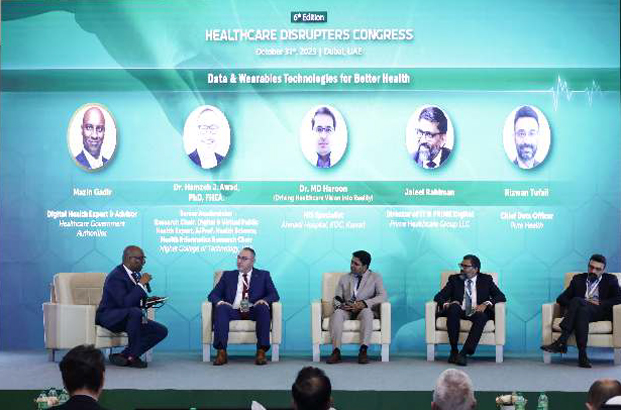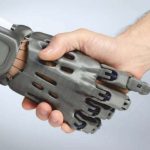In a perfect world, your heart rate, sleep habits, and even the number of steps you take each day could be the secret to transforming healthcare. This isn’t science fiction, but the rapidly evolving reality thanks to wearable devices. Weaving themselves into the very fabric of healthcare, these tiny technological marvels are poised to transform the way we diagnose, treat, and manage disease.
Recently, a group of leading minds from academia, healthcare implementation, data management, and information technology gathered to shed light on the profound impact of wearables on this dynamic landscape. Their insightful discussion illuminated the challenges and opportunities that lie ahead as we harness the power of these miniature health trackers to reshape the future of healthcare.
The quartet of distinguished speakers includes Dr. Hamzeh J. Awad, a seasoned academician renowned for his contributions to public health informatics; Dr. MD Haroon, a Healthcare Information System (HIS) specialist at Ahmadi Hospital, KOC, Kuwait, bringing frontline perspectives from one of Kuwait’s leading healthcare providers; Jaleel Rahiman, Director of IT & Prime Digital at Prime Healthcare Group, a driving force in leveraging technology for healthcare solutions; and Rizwan Tufail, Chief Data Officer at Pure Health, orchestrating data strategies across a vast healthcare network.
This symposium explored the complex interactions between research and business, revealing wearables’ potential to close the gap between innovative medical technology and real-world applications. As the experts offered their perspectives, the conversation went beyond the backgrounds of the speakers to the larger context of how technology affects patient care.
Public Health Informatics and Regulatory Landscape
Dr. Hamzeh J. Awad, a distinguished Senior Academician, set the stage by navigating through the landscape of public health informatics. His expertise shed light on the pivotal role academia plays in shaping the trajectory of data utilization in primary care centers, preventive care, and the intricate operations of hospitals. Amidst this exploration, the formidable presence of regulations, notably the Health Insurance Portability and Accountability Act (HIPAA), emerged as a cornerstone. Dr. Awad articulated how robust regulations serve as the bedrock for ensuring the ethical use of patient data, emphasizing the imperatives of privacy and confidentiality.
The dialogue seamlessly transitioned to the integration of wearable technologies into public health programs. Dr. Awad envisioned a future where wearables evolve beyond mere data collectors to active contributors shaping public health strategies. The harmonious interplay between academia, regulatory frameworks, and the burgeoning field of wearable technologies hinted at a healthcare landscape poised for a profound transformation.
Challenges in Unleashing Wearable Data
Dr. MD Haroon, an HIS specialist at Ahmadi Hospital, Kuwait, provided valuable insights into the real-world challenges of incorporating wearable data into healthcare practices. The discussion navigated through the hurdles posed by the lack of synchronization among different manufacturers’ platforms and the absence of a uniform governing body.
Dr. Haroon’s insights stressed the importance of a cohesive framework to guarantee data consistency and reliability. The slow adoption of regulations within the swiftly evolving technological landscape emerged as an urgent call to action. The discussion also explored the necessity of establishing trust in wearable data and aligning regulations with the rapid pace of innovation.
Wearable Technology in Healthcare Ecosystems
Jaleel Rahiman, as the Director of IT & Prime Digital at Prime Healthcare Group, offered a dual perspective on wearables. He acknowledged the current challenges of diverse platforms and missing regulations, yet emphasized their potential to enrich health data for community-level analysis.
His vision, exemplified by a program using calibrated devices, paints a picture of wearables as the future of healthcare, providing real-time, personalized data to revolutionize care delivery and outcomes.
Throughout, Rahiman stressed the importance of responsible data sharing and robust regulatory frameworks to unlock the full potential of wearables while safeguarding privacy.
Transformative Initiatives at Pure Health
Dr. Rizwan Tufail, the Chief Data Officer at Pure Health, took the stage to share transformative initiatives. Operating within an integrated healthcare network across the UAE, Pure Health’s endeavors extend across numerous hospitals, labs, clinics, and health insurance services. Dr. Tufail highlighted how wearables fit into their strategy of population health management.
The launch of the Pura app marked a significant step, with a focus on empowering individuals through data. The longevity pilot, involving thousands, demonstrated the potential for behavioral change fueled by wearable data. Dr. Tufail’s insights shed light on how wearables are not just data sources but tools for empowering individuals in their healthcare journey.
Dr. Tufail’s role as the overseer of various data hubs provided a unique vantage point. He emphasized the challenges faced in achieving a 360-degree view of patient data. Data quality issues, interoperability challenges, and the use of different health vocabularies across the country’s healthcare landscape surfaced as substantial hurdles. Despite these challenges, Dr. Tufail remained optimistic about the potential for wearables to bridge gaps in healthcare data and contribute to a more unified view of patient health.
Wearables as Catalysts for Upstream Influences on Health
The discourse shifted to the broader determinants of health, with Dr. Tufail underscoring that wearables are not just about downstream health outcomes but also about upstream influences. Behavioral factors, social determinants, and individual empowerment took center stage.
Dr. Tufail highlighted that wearable, as part of a 360-degree patient view, could potentially impact health outcomes by addressing these upstream factors. The narrative painted a holistic picture where wearables transcend their role as data collectors and become agents of positive change in individual health behaviors.
Academic Insights and Research Initiatives
The discussion seamlessly transitioned to Dr. Awad ‘s academic insights, exploring opportunities for academia in the realm of wearable data. He envisioned academia playing a crucial role in building databases through personal health reports and electronic health records.
Dr. Awad touched upon ongoing research initiatives, showcasing a student’s machine learning analysis aimed at preventive therapies. This intersection of academia and technology not only propels scientific advancements but also lays the foundation for evidence-based healthcare practices.
As the academic realm continues to bridge the gap between research and practical applications, wearable technology emerges as a vital conduit for collecting valuable data that informs medical breakthroughs.
Practical Application in Healthcare
Dr. Haroon revealed the priorities of Kuwait’s leading healthcare provider, Ahmadi Hospital, concentrating on preventive health. The potential integration of wearable data into the hospital’s electronic medical record system signaled a shift towards utilizing wearables as a proactive tool rather than a reactive data collector.
Dr. Haroon’s insights shed light on the practical implications of incorporating wearables into established healthcare systems, envisioning a future where real-time data seamlessly informs medical decisions. This shift not only enhances patient care but also positions wearables as integral components in the evolving landscape of modern healthcare.
Challenges, Standards, and Privacy Concerns
Rahiman ‘s insights on challenges and standards reiterated the need for a unified approach. He emphasized the importance of evaluating wearables against standards and raised critical concerns about data privacy and awareness.
The absence of clear regulations in the industry, particularly regarding data sharing, underscored the complexity of navigating the wearable landscape responsibly. He further highlighted the delicate balance required between technological innovation and ethical considerations. As wearables become more ubiquitous, addressing privacy concerns and establishing industry standards emerge as paramount to fostering trust among users and stakeholders alike.
The Crucial Role of Standards and Data Privacy
As the panel delved into the intricacies of wearables, a consensus emerged on the critical role of standards and data privacy. Dr. Tufail, drawing from his extensive experience, emphasized the need for standardized protocols in the realm of wearables. The absence of universal standards poses challenges in data interpretation, especially with the plethora of devices available.
The conversation expanded to encompass data privacy—a crucial aspect often overlooked. Dr. Tufail stressed the need for robust regulations to govern the sharing and utilization of wearable-generated data, striking a delicate balance between innovation and safeguarding individual privacy.
The Road Ahead: A Comprehensive Outlook
The panelists, each contributing a unique perspective, collectively outlined a roadmap for the future. A vision where wearables seamlessly integrate into personalized, proactive, and patient-centric healthcare emerged. The need for collaboration, standardization, and a patient-centric approach echoed throughout the discussion. The road ahead involves navigating through regulatory landscapes, technological advancements, and societal perceptions to actualize a future where wearables contribute not just to data collection but to holistic well-being.
In conclusion, the transformative dialogue not only unveiled the intricacies of wearables and data integration but also offered a glimpse into the future of healthcare—a future where individuals are active participants in their well-being, data is a tool for proactive care, and collaboration across sectors defines the new paradigm of patient-centric healthcare.
The narrative continues, inviting stakeholders to join hands in sculpting a future where wearables seamlessly integrate into the fabric of personalized, proactive, and patient-centric healthcare. As we reflect on this transformative dialogue, it’s evident that wearables are catalysts for a paradigm shift in healthcare, transforming it from reactive to preventive and from standardized to personalized.
















